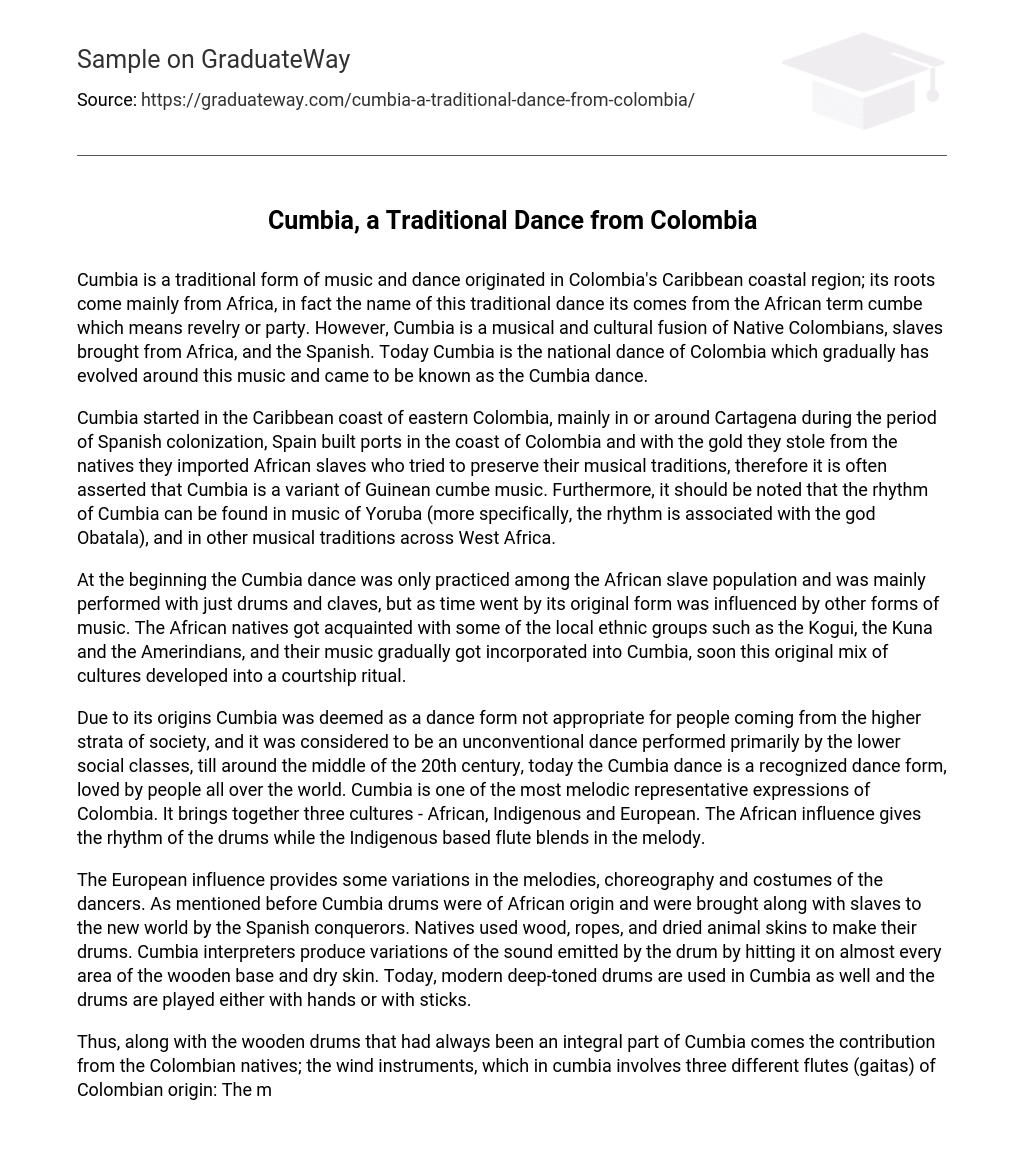Cumbia is a traditional form of music and dance originated in Colombia’s Caribbean coastal region; its roots come mainly from Africa, in fact the name of this traditional dance its comes from the African term cumbe which means revelry or party. However, Cumbia is a musical and cultural fusion of Native Colombians, slaves brought from Africa, and the Spanish. Today Cumbia is the national dance of Colombia which gradually has evolved around this music and came to be known as the Cumbia dance.
Cumbia started in the Caribbean coast of eastern Colombia, mainly in or around Cartagena during the period of Spanish colonization, Spain built ports in the coast of Colombia and with the gold they stole from the natives they imported African slaves who tried to preserve their musical traditions, therefore it is often asserted that Cumbia is a variant of Guinean cumbe music. Furthermore, it should be noted that the rhythm of Cumbia can be found in music of Yoruba (more specifically, the rhythm is associated with the god Obatala), and in other musical traditions across West Africa.
At the beginning the Cumbia dance was only practiced among the African slave population and was mainly performed with just drums and claves, but as time went by its original form was influenced by other forms of music. The African natives got acquainted with some of the local ethnic groups such as the Kogui, the Kuna and the Amerindians, and their music gradually got incorporated into Cumbia, soon this original mix of cultures developed into a courtship ritual.
Due to its origins Cumbia was deemed as a dance form not appropriate for people coming from the higher strata of society, and it was considered to be an unconventional dance performed primarily by the lower social classes, till around the middle of the 20th century, today the Cumbia dance is a recognized dance form, loved by people all over the world. Cumbia is one of the most melodic representative expressions of Colombia. It brings together three cultures – African, Indigenous and European. The African influence gives the rhythm of the drums while the Indigenous based flute blends in the melody.
The European influence provides some variations in the melodies, choreography and costumes of the dancers. As mentioned before Cumbia drums were of African origin and were brought along with slaves to the new world by the Spanish conquerors. Natives used wood, ropes, and dried animal skins to make their drums. Cumbia interpreters produce variations of the sound emitted by the drum by hitting it on almost every area of the wooden base and dry skin. Today, modern deep-toned drums are used in Cumbia as well and the drums are played either with hands or with sticks.
Thus, along with the wooden drums that had always been an integral part of Cumbia comes the contribution from the Colombian natives; the wind instruments, which in cumbia involves three different flutes (gaitas) of Colombian origin: The male flute or gaita macho which gives rhythmic and harmonic support to the female flute or gaita hembra which carries the melodies. Finally, the flauta de millo or millo flute which is a native Colombian instrument made from the millo cane and used to help carry the melody.
Initially, cumbia was only instrumental and the inclusion of lyrics and vocals came with. Some European instruments were added later including the guitar, the Caja (descendant of the Spanish military drum), the accordion, the bass guitar, the clarinet, and the modern flute. Cumbia music, which featured dance prominently, was traditionally performed with music played by pairs of men and women and with male and female dancers. Originally Cumbia is danced by men and women dressed in white.
The women wears the long, multi-layered traditional skirt of the area and the men wears white pants folded up to the ankle, the traditional (sombrero vueltiao) Colombian hat, and a red scarf around their necks that they use during the dance to wave it in circles in the air, or held out for the women to hold. This dance form initially began as a dance of courtship and had young couples tapping their feet to the beat of the drums. Consequently, the men attempts to win over the women with his dancing and by ritually passing her fire from his bouquet of candles as they gather in a circle.
Couples moved to the center to dance with the women who playfully waved their long skirts while holding a candle, and simultaneously pushing the man away and enticing them closer, in the center the men danced with one hand on his back and the other holding his traditional hat, putting it on and off. Over time the look of cumbia has changed as the clothing has become brighter and the dance is frequently performed by troupes of women in their carnivals. However the basic steps and structure of the dance remains easily recognizable from its origins.





